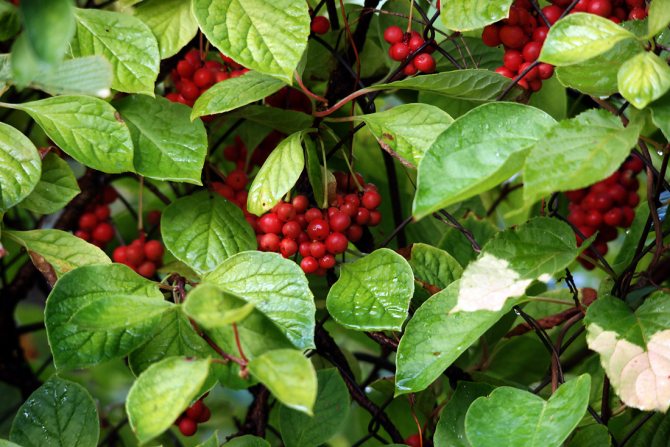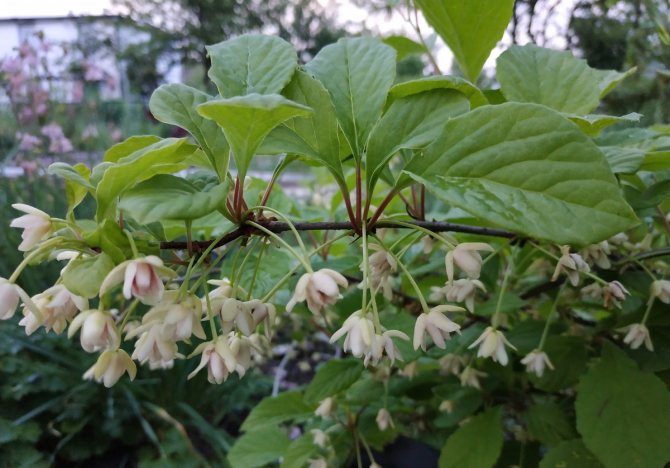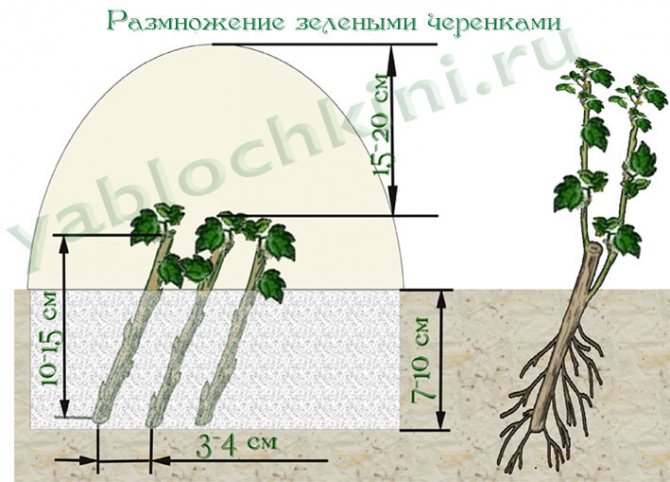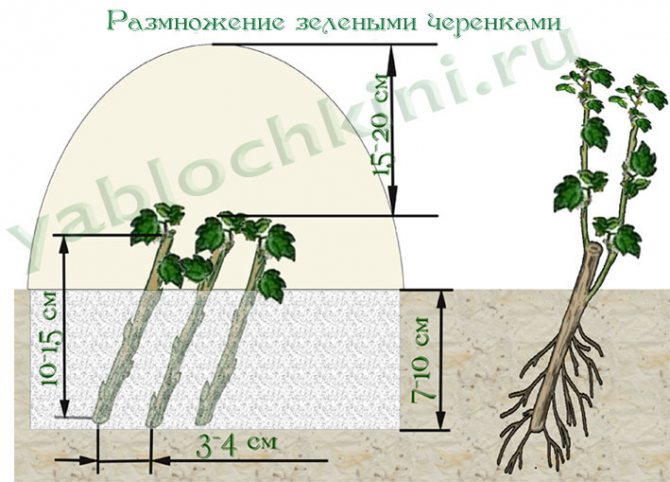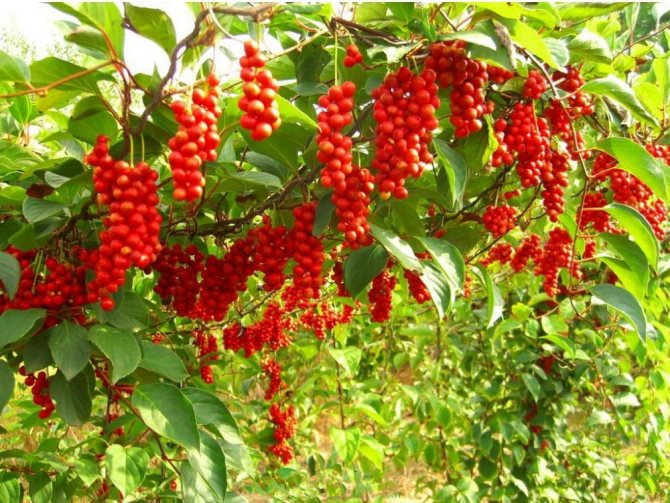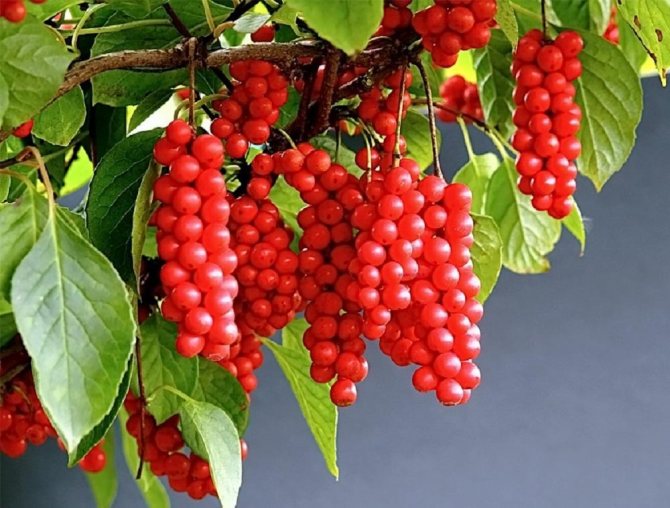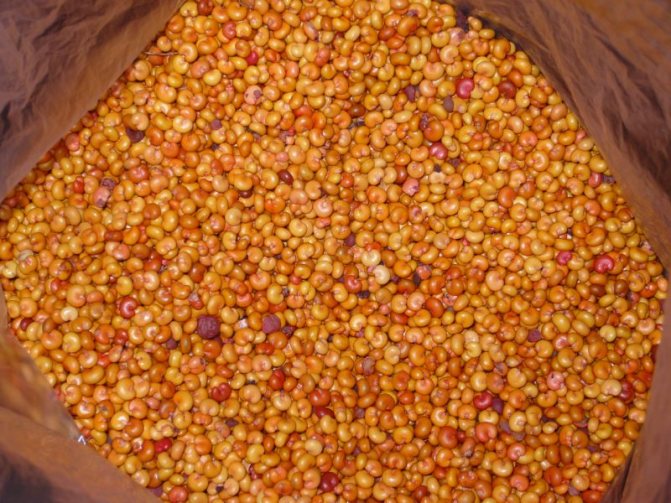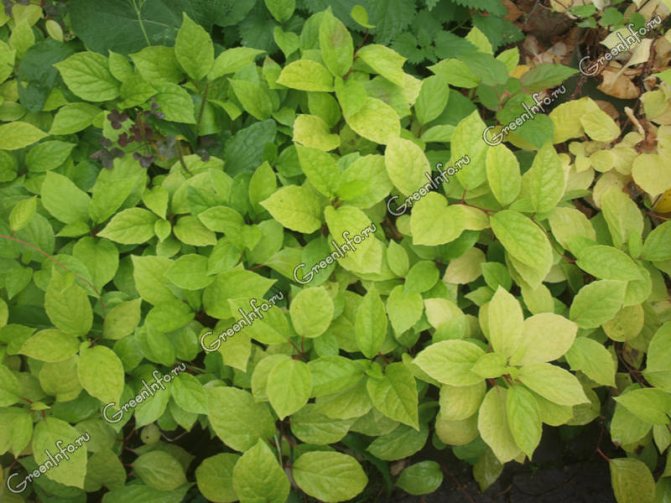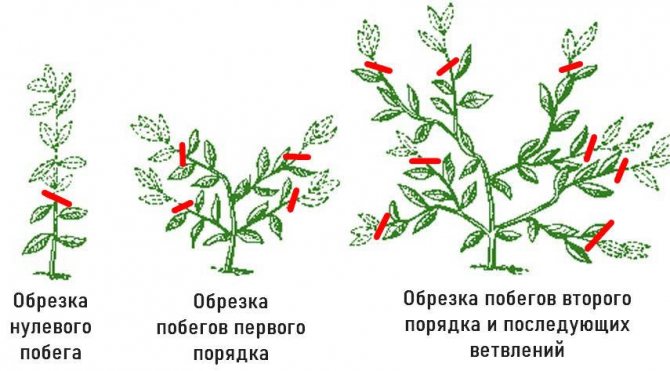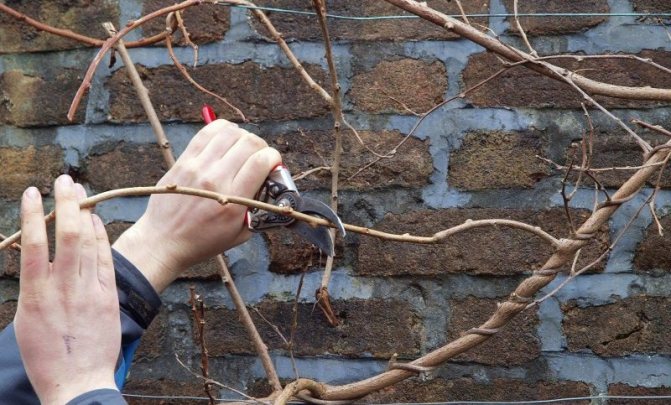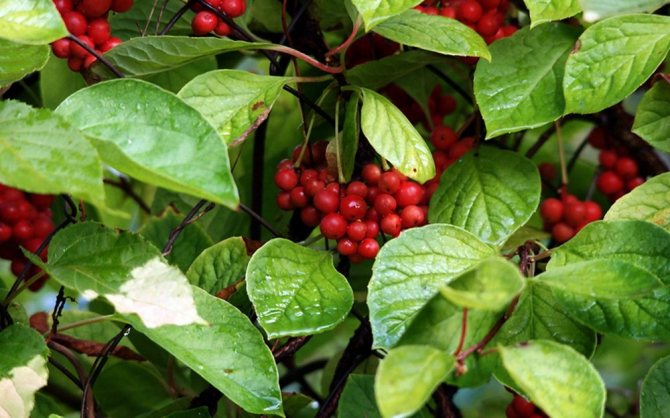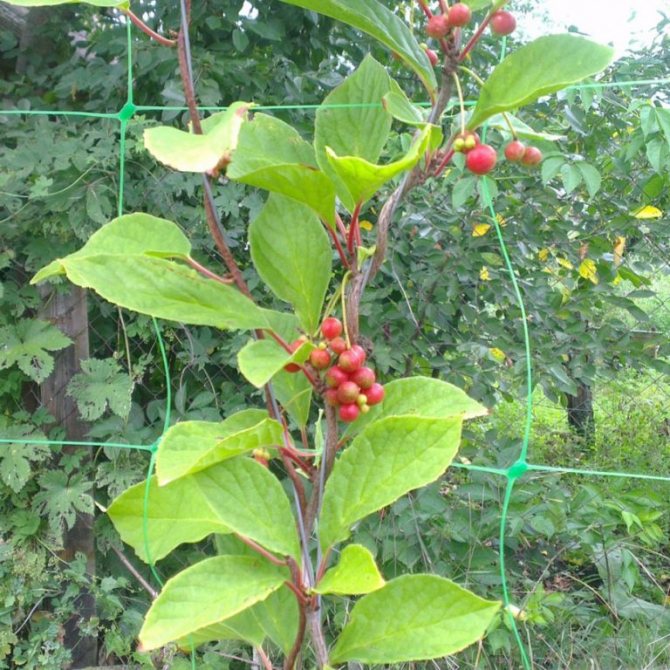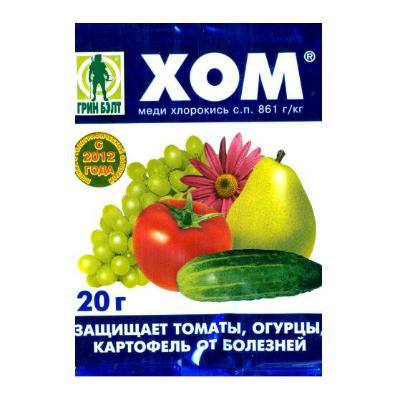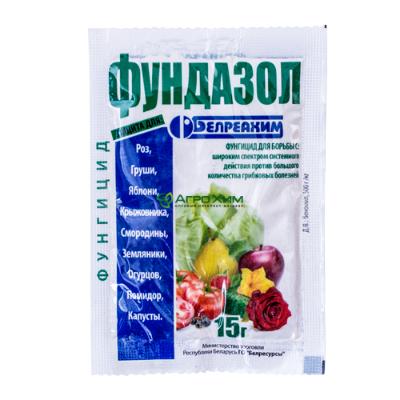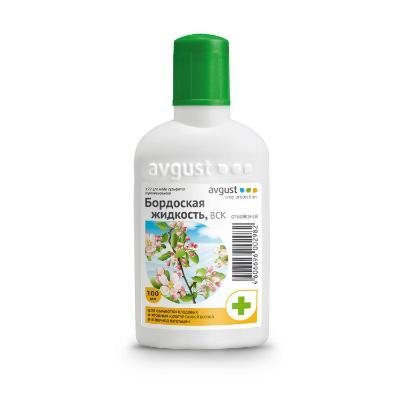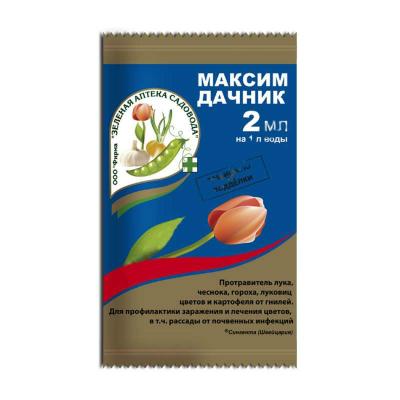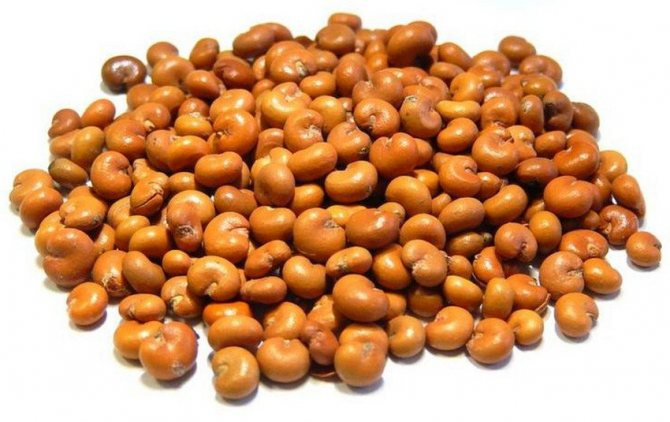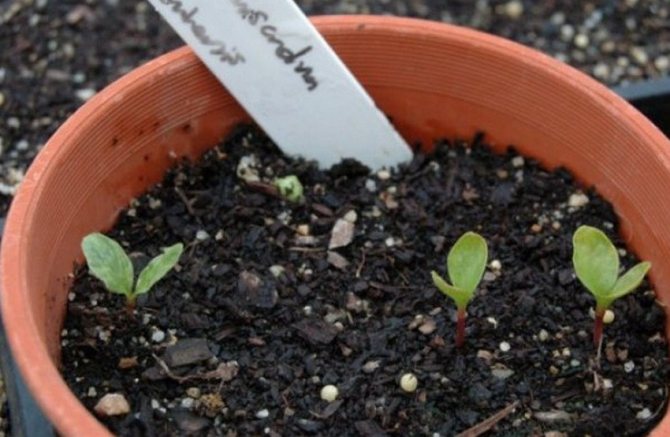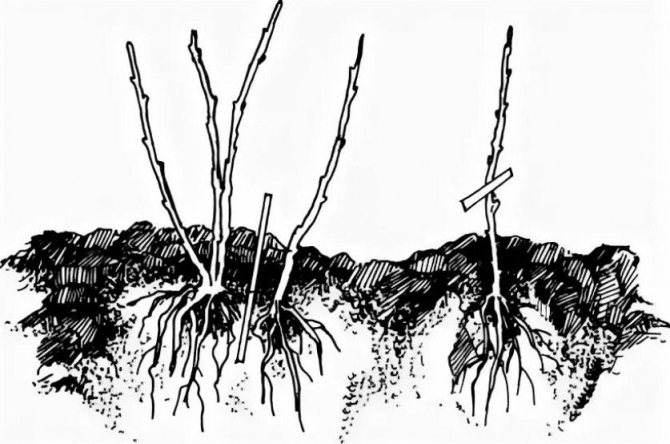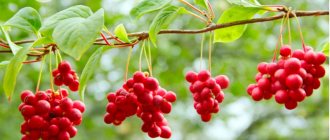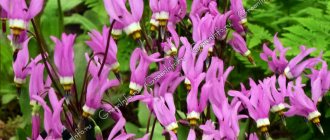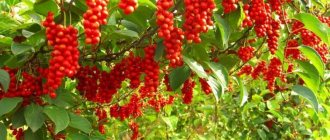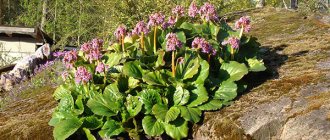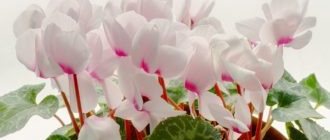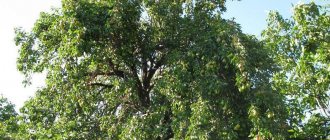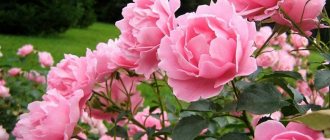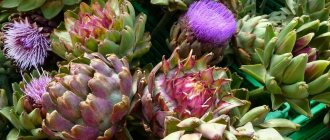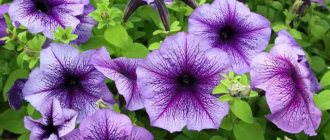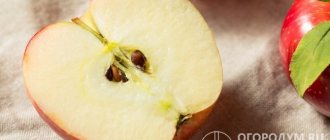Chinese schisandra (Schisandra chinensis) is not only useful, but also a very beautiful plant. From spring to autumn, the liana pleases the owners. In the spring it grows prettier, covered with snow-white fragrant flowers, in the summer it is made into an elegant cluster of ripening berries, which turn red in the fall against the background of lemon-yellow foliage. In the spring, plant seedlings, put up supports, do not forget to water and feed, and lemongrass will decorate the garden for your care, and add vitality, and heal ailments.
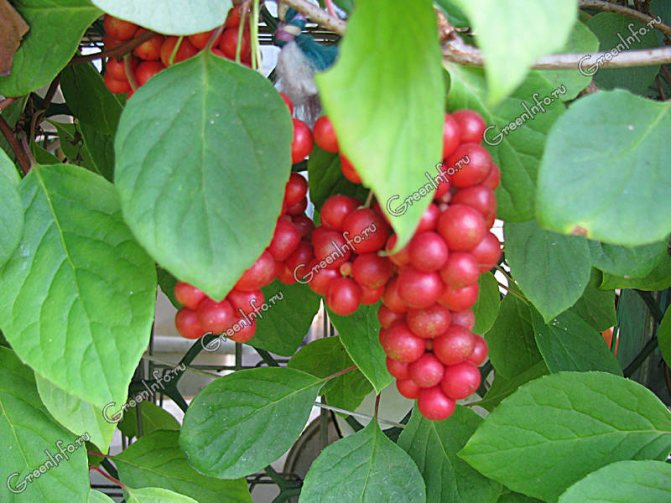
Chinese Schisandra (Schisandra chinensis)
Planting and caring for Chinese lemongrass
- Bloom: from the fifth to sixth year of life at the end of May or at the beginning of July. Flowering lasts about two weeks.
- Landing: in October or late April or early May.
- Lighting: bright sunlight or partial shade.
- The soil: light, rich in humus, moderately moist and drained.
- Watering: frequent and plentiful: 6-7 buckets of water are poured under each bush.
- Top dressing: from the third season, once every 2-3 weeks, organic fertilizer is introduced into the trunk circle - a solution of chicken manure or mullein. The trunk space is mulched with a layer of humus or sheet compost. In autumn, 20 g of superphosphate and 100 g of wood ash are embedded in the soil under each plant to a depth of 10 cm.
- Garter: the trellis on which this vine is grown is installed immediately after planting. When the liana is located near the wall of the building, it is allowed to run along a ladder set obliquely to the wall.
- Cropping: from the third year after planting, formative pruning begins, which is carried out in the fall, after leaf fall. Unnecessary root processes are also removed.
- Reproduction: seeds, root cuttings and shoots.
- Pests: not amazed.
- Diseases: powdery mildew, ramulariasis, ascochitis and fusarium.
- Properties: is a valuable medicinal plant.
Read more about the cultivation of schisandra chinensis below.
Pruning
Lemongrass is pruned 2-3 years after planting. By this time, the increased growth of roots is replaced by the rapid development of the aboveground part. Of the numerous shoots that have appeared, 3-6 are left, the rest are removed at the soil level. In adult plants, unproductive branches at the age of 15-18 are cut out and replaced with young ones, selected from the shoots.
It is better to cut lemongrass in the fall, after falling leaves. If the vine is very thickened, then pruning can be done in June-July.
In late spring and winter, the vines are not pruned, because after pruning, there is abundant juice production (crying of the vine) and drying out of the plants. Only root shoots can be removed in spring, and this must be done annually. Root shoots are cut below soil level.
With sanitary pruning, first of all, dried, broken and small branches that thicken the crown are removed. Long lateral shoots are shortened in time, leaving 10-12 buds.
Chinese schisandra - description
The plant is a climbing deciduous liana up to 15 m long with a trunk up to 2.5 cm in diameter and shoots covered with brown-brown bark, peeling on old ones, and shiny and smooth on young ones. Both the shoots and leaves of lemongrass have the characteristic citrus scent that gives the plant its name.
Leaves of lemongrass are dense, obovate or elliptical, with a wedge-shaped base and a few and implicitly pronounced teeth along the edges. Leaves are connected with shoots by pink or red petioles up to 3 cm long. In spring and summer, the upper part of the leaf plate is light green, shiny, glabrous, and the lower part is glaucous, with pubescence along the veins. In autumn, the leaves of Schisandra chinensis are colored yellow-orange and ocher-yellow.
Growing lemongrass: planting and care in the open field
Fragrant waxy white dioecious flowers up to 2 cm in diameter on drooping pedicels are located in 3-5 pieces in the leaf axils. The composite cluster-like fruit up to 10 cm long consists of edible spherical two-seeded berries of red color and sour taste. The berries of the Chinese magnolia vine also have a characteristic plant smell. The bud-shaped seeds of Schisandra chinensis remain viable only until spring.
- Levkoy: planting and care in the open field
Flowers and fruits
Lemongrass flowers are 1.3–1.8 cm in diameter, creamy white, with a delicate pleasant aroma. Male flowers are slightly smaller than female ones, with white stamens accreted along their entire length, so that only yellowish anthers remain free. After flowering, male flowers fall off along with the peduncle. Female flowers have a greenish pistil, consisting of numerous carpels. Lemongrass is pollinated by small beetles and hymenoptera (bees, wasps, bumblebees, etc.).
Schizandra is unstable to late spring frosts. Vines bloom around May 25–31. Male flowers bloom 1-2 days earlier than female ones. Plants bloom for one to two weeks.
The fruit is a juicy composite leaflet, resembles a cylindrical brush 2–16 cm long and contains (in the Non-Black Earth Zone) from 2–4 to 15–25 red berries. The mass of the brush reaches 7–15 g. Each berry contains 1–2 seeds. In 1 g - up to 40-60 seeds. They germinate unevenly.
The fruits ripen in mid-September. The brushes can hang on the vines until the leaves fall (until the first half of October). During the period of full fruiting, up to 2.5 kg of fruits are obtained from one 15–20-year-old plant. In the conditions of the Leningrad region and to the north, lemongrass gives abundant harvests every 2-3 years. This frequency of fruiting is primarily due to the influence of weather on the formation of flowers (in July-August).
Planting schisandra chinensis
When to plant Chinese lemongrass
The cultivation of schisandra chinensis and its care is carried out not only for medicinal purposes, but also to decorate the site, since the plant has high decorative qualities. In areas with a warm, mild climate, lemongrass is planted in October, and in the middle lane, planting is carried out in late April or early May. Professionals recommend planting at least three plants at a distance of 1m from each other. If you want to grow a vine near your house, step back 1-1.5 m from the wall so that water from the roof does not drip onto the lemongrass.
How to plant Chinese lemongrass
Lemongrass prefers light, humus-rich, moist and drained soil. The plant is shade-tolerant, but will thrive better in a well-lit area.
Two-three-year-old seedlings are used as planting material, in which, with a shoot height of only 10-15 cm, the root system is well developed. Before planting, the taller shoots of the seedling are shortened to 3 buds, and the roots are cut to 20-25 cm.
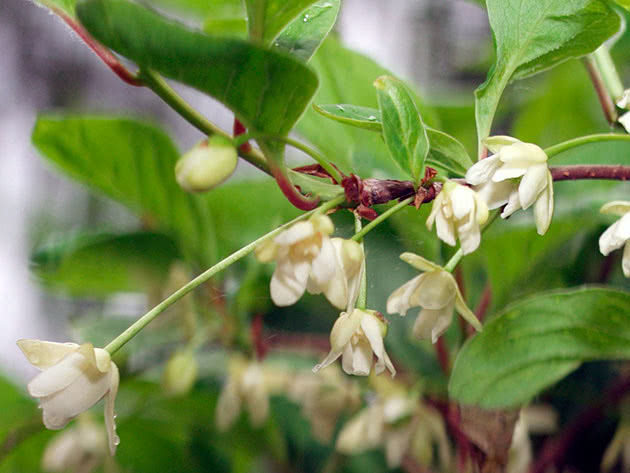

A planting hole for Chinese magnolia vine is dug with a diameter of 60-70 cm and a depth of at least 40 cm.A layer of drainage of expanded clay, broken brick or crushed stone 10 cm thick is laid on the bottom, and a soil mixture is prepared from equal parts of humus, leaf compost and sod to fill the hole earth, adding 200 g of superphosphate to it, half a kilogram of wood ash and mixing thoroughly. Before planting, the soil mixture is poured onto the drainage layer with a slide.
Dip the roots of the seedling in a clay mash, to a bucket of which you should add 1 liter of mullein, and place the plant on a mound so that its root collar is at surface level after planting. Spread out the roots of lemongrass and fill the hole with prepared fertile soil. Then tamp the soil in the near-trunk circle and water it abundantly, and when the water is absorbed, fill the root hole with humus or peat. Saplings of Chinese Schizandra take root very quickly, but it is advisable at first to protect them from the bright sun, to ensure regular watering and evening spraying in dry weather.
Indoor plant lemongrass
The apartment feels good. In its natural environment, the vine grows in the forest and is adapted to diffused sunlight, so lemongrass should be supplemented in the room only in winter.
Top dressing with potash and phosphorus fertilizers serve as sufficient nutrition for the superficial root system of the vine.
Does not tolerate lemongrass when grown in a watering room with unboiled tap water and dry air. In the summer, the plant is sprayed, and for the winter, part of the trunk is covered with sand.
Chinese lemongrass care
Growing schisandra chinensis
Planting schisandra chinensis and caring for it is not time consuming and will not take much of your time. The main care activities are watering, loosening the soil, removing weeds, feeding, spraying in a prolonged dry heat and pruning.
During the growing season, lemongrass is watered often and abundantly: 6-7 buckets of water are poured under the plant at a time. The next day after wetting or rain, you need to loosen the soil around the vine and remove the weeds. Do not neglect the evening spraying of Chinese magnolia vine in the heat. Especially young vines need this procedure. To prevent rapid evaporation of moisture from the soil, it is best to always keep the trunk circle under an organic mulch.
Chinese lemongrass are fed from the third year of life: during the spring and summer, a solution of organic fertilizers - cow (1:10) or chicken (1:20) manure is introduced into the soil once every two to three weeks. A good result is obtained by mulching the trunk circle of Chinese magnolia vine with humus or sheet compost. After leaf fall, 100 g of wood ash and 20 g of superphosphate are applied under each bush, followed by embedding to a depth of about 10 cm with the obligatory subsequent watering of the soil in the near-trunk circle.
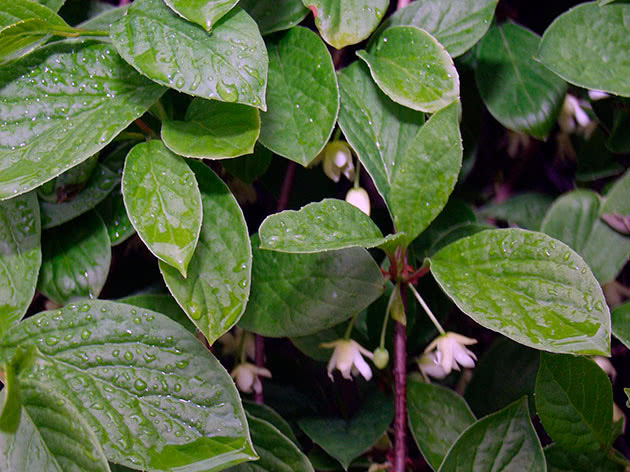

Fruiting vines during the flowering period are fed with Nitrofoska at the rate of 50 g per m², and after flowering, a solution of fermented mullein or bird droppings is poured under the plant in a bucket. In autumn, 60 g of superphosphate and 30-40 g of potassium sulfate are scattered under the bushes, and once every 2-3 years, compost is placed under each plant to a depth of 6-8 cm at the rate of 4-5 kg per m².
Schisandra chinensis, since it is a vine, is grown on a trellis, which is installed in the year of planting. This arrangement of branches and shoots allows the sun's rays to better illuminate the plant, and this contributes to the formation of larger fruits and an increase in yield. If you grow lemongrass without support, it is unlikely to bear fruit. The trellis is made of pillars of such a height that, after digging in to a depth of 60 cm, they rise 2-2.5 m above the ground.The distance between the pillars is maintained about 3 m, and they are connected together by three rows of horizontal wire guides, the lower of which is stretched over a height of 50 cm from the ground, and the next ones every 70-100 cm. In the first year, the grown shoots are tied to the lower guide, and in subsequent years - to those that are located above. The shoots are fixed on the support with a fan. For the winter, Chinese lemongrass is not removed from the trellis.
If you plant a vine near the house, then a ladder installed obliquely can be used as a support.
Pruning lemongrass begins in the third year after planting, when the development of its root system is replaced by increased growth of shoots. Not only the decorativeness of Schisandra chinensis, but also the quality of its fruiting depends on correct pruning. At the first formative pruning, from 3 to 6 of the strongest and most correctly located shoots are left on the bush - the future skeleton of the plant, and the remaining shoots are cut out at ground level. In the future, pruning of Schisandra chinensis is carried out twice a year: in autumn and summer. In the fall, after all the leaves have fallen from the plant, the weak, diseased, improperly growing and dried shoots that have formed over the summer are cut out. The part of the vine that has been actively bearing fruit for the last three years should also be removed. This is done so that young shoots of the vines can develop and produce a harvest.
In summer, lemongrass is cut only if the plant has formed too many young shoots. Professionals advise to cut branches 10-12 buds from the edge. In addition, it is necessary to fight annually with root suckers, as well as regularly replace old skeletal branches with new strong shoots from the root growth.
- Levkoy: planting and care in the open field
Pests and diseases of Schisandra chinensis
Schisandra has good immunity and, subject to agricultural technology and good care, is very rarely affected by diseases. It is also resistant to pests. However, if you got infected planting material, you need to be prepared to confront diseases. Most often, lemongrass is affected by spots, powdery mildew and fusarium wilt.
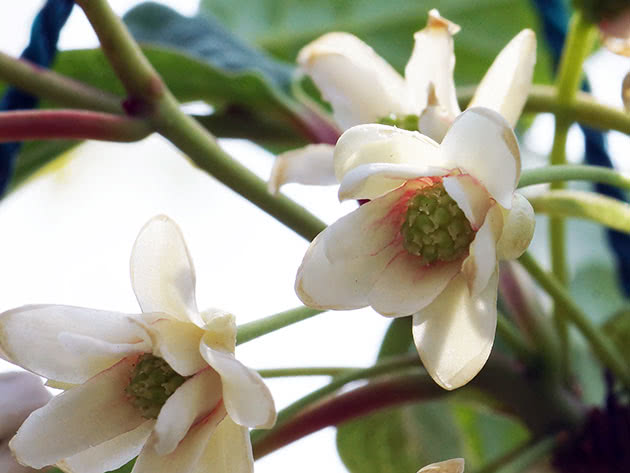

Of the lemongrass lemongrass, ramulariasis and ascochitosis are affected. Blurry brown spots and edging on the leaves are the main signs of these diseases. Black dots may appear on the underside of the leaf plate - fungal pycnidia. The diseased leaves must be removed and burned, and the vine must be treated with one percent Bordeaux liquid or another copper-based fungicide.
Powdery mildew covers the leaves and stems of the plant with a sloppy, whitish coating. As a result of the development of the disease, lemongrass leaves fall prematurely. Powdery mildew also affects shoots, buds and roots of Schisandra chinensis. If its symptoms are found, all affected leaves should be removed, and the plant should be treated with sulfur powder and soda ash solution until the vine recovers. The intervals between treatments are 7-10 days.
Fusarium can affect lemongrass at any age, but more often this problem happens to young plants. The cause of the disease is, as a rule, infection of the planting material. Withering is manifested by the formation of rotting areas on the root collar and roots of the plant. Lemongrass stems darken, become thinner, the leaves turn yellow and fall off, and the vine dies from vascular blockage. It is impossible to cure Chinese magnolia vine from fusarium, but it is quite possible to prevent the development of the disease if the seeds and seedlings are treated with a fungicide solution before sowing and planting, and the soil with Trichodermin. If the plant is still sick, it will have to be removed and burned, and healthy bushes, until they become infected, should be treated with a solution of potassium permanganate.
Schisandra chinensis in the Moscow region
Schisandra chinensis in the Moscow region has long been not uncommon, as is schisandra chinensis in the Urals, since the plant normally tolerates even harsh winters up to -35 ºC, and the decorative and healing qualities of this culture, as well as unpretentious care, make the Far Eastern vine more and more popular among gardeners. lovers. In the middle lane, Chinese lemongrass does not need to be laid on the ground or covered for the winter, only young plants need protection from the cold, and then only in the first winter.But in the conditions of Siberian frosts, the lashes are carefully removed from the trellis, they are placed on the laid spruce branches or straw and abundantly sprinkled on top with leaves, straw or covered with spruce branches.
Plant diseases and pests
Pests do not settle on this plant - they are frightened off by the sour smell of lemon.
Schizandra fungal diseases:
- Phylostictosis. Symptoms are dark spots with a purple circle on the leaves. The plaques grow, holes appear in their place. It is necessary to treat with preparations containing copper - Ordan, Hom.
- Powdery mildew. White bloom on the leaves, which can appear on both sides of the leaves. It appears during sudden cold snaps and in prolonged damp weather. In the early stages, it is treated with a solution of soda ash. The use of fungicides is possible - Topaz, Fundazol.
- Ascochitosis is a type of rot. It appears as small brown spots. It is treated with Bordeaux liquid.
- Fusarium. The disease is found on the stem in the lower part and at the roots. It has the appearance of a brown ring that softens the base of the stem. In a neglected state, the plant will die. It is best to remove a diseased seedling early, before it has infected nearby vines. After removing the diseased sprout, the soil is disinfected with a solution of potassium permanganate. To prevent this disease, seeds are treated with the fungicide Maxim.
- Ramulariasis. Brown spots appear on the leaves, which eventually become covered with a white bloom. The disease reduces the amount of the crop in half. It is treated with Bordeaux liquid and fungicides. Before spraying, diseased areas of the plant are removed and burned outside the garden area.
In case of a disease of one Schisandra bush, it is necessary to carry out prophylaxis of all seedlings on the site in order to avoid mass infection.
Preparations for the treatment and prevention of lemongrass diseases.
| Name, price | Description |
| Hom 42 rub.
| Fights fungal diseases:
Composition: copper oxychloride. When interacting with metal, the drug causes its corrosion. |
| Ordan 46 rubles.
| Disinfects the plant from fungal diseases. It contains copper oxychloride and cymoxanil. Unlike Homa, Ordan has healing functions - it restores the structure of the plant. |
| Topaz 70 rub.
| It is used to treat powdery mildew and rust. Ingredients: Penconazole. The fungicide can be used in wet weather, it is not washed off by precipitation. |
| Fundazol 40 rubles
| Destroys fungal diseases in plant seeds:
Forms a protective coating around the leaves. Can be used in all weather conditions. It also kills pests:
The composition contains benomyl. |
| Bordeaux liquid 100 rubles.
| Protects plants from all fungal diseases. When cooking on your own, you need to observe the proportions of 1 part of lime to 1 part of vitriol, otherwise the fungicide will burn the leaves. Structure:
|
| Maxim 23 rub.
| The preparation is natural in origin, the active substance is secreted by beneficial soil bacteria. It can be used both in the treatment of seeds against fungal diseases, and for the treatment of adult plants. Ingredients: fludioxonil. |
Reproduction of schisandra chinensis
Lemongrass propagates by seeds, shoots and root cuttings, but all the properties of the mother plant are preserved only during vegetative propagation.
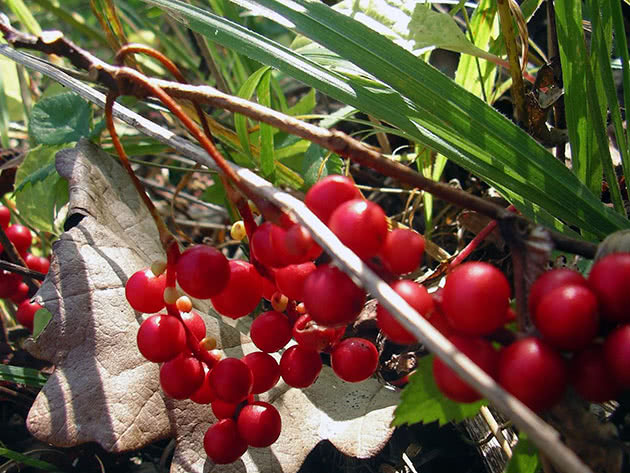

Reproduction of schisandra chinensis seeds
The easiest way is to sow lemongrass seeds in prepared beds before winter immediately after they are harvested. You can sow in spring, but in this case the seeds are stratified: they are kept in the lower drawer of the refrigerator for two months.There is a very effective way of preparing seeds for sowing, developed by professionals: they are stored in fruits until January, then they are washed from the pulp, folded into a nylon stocking and placed under constantly flowing water. At home, the seeds in the stocking can be kept in the toilet cistern so that they are in fresh, clean water after each flush. Four days later, the seeds are squeezed out, placed directly in a stocking in a container with wet calcined sand and kept at a temperature of 18-20 ºC for a month, after which the container with seeds is buried in the snow for stratification. After a month, the seeds are brought into a room with a temperature of 10 ºC and observed: after a week or two, they begin to crack, and then they can be sown to a depth of 5 mm in boxes with a mixture of sand and humus in equal parts. The crops are covered with paper and watered daily. Seedlings with large cotyledons, similar to cucumber sprouts, will appear in 1-2 weeks. Seedling care consists in protection from direct sunlight, watering and 1-2 treatments with a weak solution of potassium permanganate to prevent blackleg and other fungal diseases. At the stage of development of 3-4 true leaves, the seedlings dive into larger boxes according to the 5x5 cm scheme, and in early June, after the heat is finally established, the hardened seedlings of Schisandra chinensis can be planted in open ground in partial shade. The feeding area of one plant is 10x10 cm². Protect the seedlings from too strong sun, and with the onset of autumn, cover them with spruce branches or a thick layer of foliage. Chinese lemongrass from seeds is planted in a permanent place at the age of two to three years.
Reproduction of schisandra chinensis by shoots
The most effective way of reproduction is to shed the shoots. Liana is literally surrounded by many shoots, on which dormant buds are located. The offspring are separated from the bush and immediately transplanted to a permanent place. In the southern regions, this can be done before the start of sap flow and after leaf fall, and in the northern ones - only in early spring.
Reproduction of lemongrass by root cuttings
Pieces of roots from 5 to 10 cm long with several dormant buds are cut from the rhizome and, so that the overgrown roots do not dry out, immediately sprinkle the pieces with moist soil or cover with a wet napkin. Then the root cuttings are planted in a garden bed or in a cold greenhouse according to the 10x10 scheme and covered with a layer of fertile soil 2-3 cm thick. Planting care consists in regular watering. In the spring of next year, the cuttings that have sprouted are planted in a permanent place.
Cuttings
Reproduction by cuttings must be carried out in mid-June before or during flowering. To do this, cut off green-brown shoots that are not lignified. The stalk should be 4–8 cm long and have 3-4 buds. The upper cut is straight, the lower one is oblique. The distance from the cut to the nearest kidney is about 5 mm. Treating the cuttings with a growth stimulant will help rooting. From stimulants, you can use "Heteroauxin". It is diluted with water in a ratio of 1:10.
The cutting of Schisandra chinensis is carried out in stages:
- A greenhouse is being prepared for disembarkation.
- Cut the cuttings of the green shoots to the desired length.
- They are treated with a growth stimulant throughout the day.
- Landing is carried out, watering.
- Cover the landing with film or glass.
Did you know? Lemongrass juice is used to create an unusual smell in wine.
For rooting, cuttings are planted in a greenhouse... The soil for the greenhouse is used light, fertile, covering it with a layer of sand 3-4 cm thick. Planting is carried out in rows at a distance of 5 cm from each other in an inclined form. Planting depth - 2-3 cm to the second bud from the bottom. The planting is watered, and the greenhouse is covered with film or glass.
Airing and spraying cuttings with water should be carried out regularly throughout the summer.... It is also necessary to ensure that the soil does not dry out. For the winter, it is better to hide the cuttings from freezing in the basement.To do this, it is necessary to dig them up together with a lump of earth and put them in a box. It should be planted in a permanent place in the spring. If 50% of the cuttings are rooted, this is a good result.
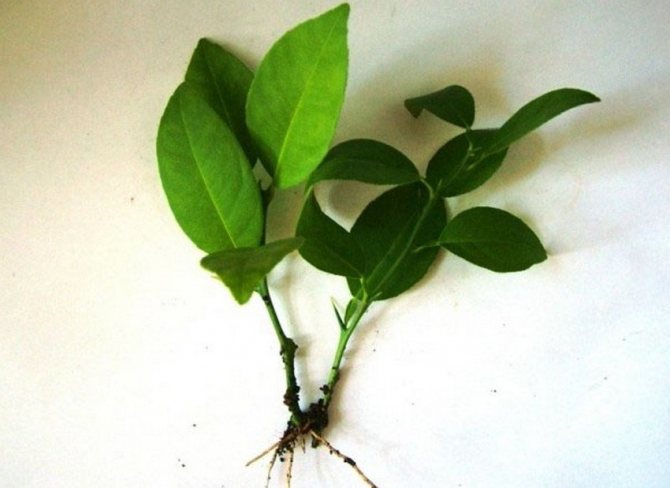

Chinese Schisandra varieties
Unfortunately, there are not so many varieties of Chinese magnolia vine. Currently, the most famous of them are:
- Sadovy-1 - a self-pollinating highly productive winter-hardy variety, the branches of which reach a length of 10 m. The fruits of Chinese magnolia vine of this variety consist of spherical juicy and sour red berries with a lemon scent, collected in racemes up to 10 cm long;
- Mountain - a winter-hardy and productive variety of medium ripening, relatively resistant to diseases and pests. Compound fruit up to 9 cm long and weighing up to 13 g consists of 15-17 dark red berries of bitter-sour taste;
- Volgar - winter-hardy, drought-resistant, practically not affected by diseases and pests lemongrass of late ripening and universal purpose. It is a monoecious liana with fruits weighing up to 7.3 g, consisting of 14-15 round red fruits with a sour taste with a resinous aroma;
- Firstborn - frost-resistant and resistant to diseases and pests, medium-ripening variety of Russian selection with carmine-red fruits with juicy bright red pulp, specific sour taste and lemon aroma;
- Myth - a hybrid variety of unknown origin with medium-length seedlings, consisting of 15 red fruits with a pleasant sour taste.
Lemongrass in the Moscow region
Chinese or Far Eastern lemongrass can be grown in the Moscow region (middle lane), in the Urals and Siberia. The plant is adapted to cold climates and survives frosty winters well.
Protect young seedlings from frost. For the winter, they are bent down and covered with a layer of leaves or needles. Spruce spruce mulch repels rodents that can damage the plant. You can open the plant in early spring.
After 2-3 years, lemongrass can be left uncovered for the winter.
Schisandra is an unpretentious and beautiful plant with a pleasant aroma that will delight gardeners for many years. Schizandra berries are tasty and healthy. Simple planting and caring for the plant, the beneficial properties of garden lemongrass have made it popular throughout Russia. If you take into account the recommendations and tips for growing and caring for lemongrass, then garden culture will not cause trouble for gardeners.
Properties of schisandra chinensis - harm and benefit
Medicinal properties of Chinese lemongrass
For medicinal purposes, most of the fruits and seeds of the plant are used. Schizandra chinensis fruits contain resinous substances, schizandrin, potassium, organic acids (malic, citric and tartaric), vitamins, mineral salts, trace elements copper, iodine, selenium, manganese, iron, zinc, essential oil.
They knew about the beneficial properties of this species even in ancient China and actively used the plant in pharmacology. Today, Chinese magnolia vine is grown on an industrial scale. The berries of the plant have the ability to tone and stimulate the nervous system, so Nanai hunters, setting off on a journey, take a handful of dried fruits with them. And not so long ago, tests with the participation of military personnel and athletes showed that lemongrass has the property of relieving fatigue during intense physical exertion: only 2-5 lemongrass berries have a stronger effect than phenamine or cola, but, unlike these stimulants, they do not give negative side effects. The berries of schisandra chinensis are also shown to those who are engaged in intense mental work, and it is very important that their tonic effect does not deplete nerve cells.
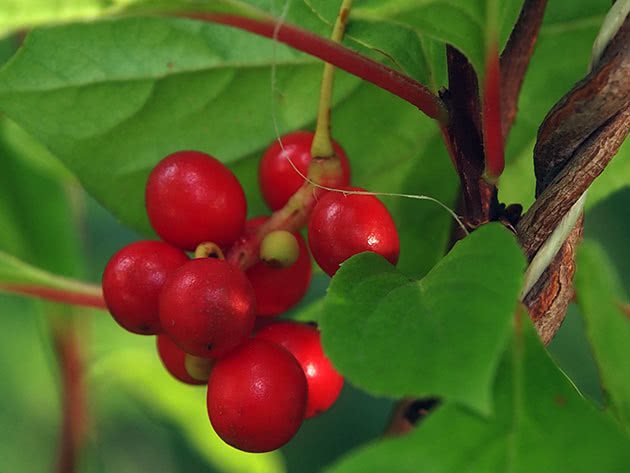

Schizandra preparations increase the body's resistance to diseases and adverse environmental influences, stimulate the respiratory system and the work of the heart muscle.Often they are prescribed for the complex treatment of diseases resulting from an asthenic and depressive state. Indicative is the fact that as a result of taking medications of Schisandra chinensis, there were no signs of overexcitation.
Fresh juice from lemongrass is able to inhibit the development of many pathogens. The high efficiency of the treatment of chronic gastritis with plant seeds has been proven: even a single intake of powder from Schisandra chinensis seeds led to the normalization of gastric acidity in patients suffering from either too high or low levels.
- Levkoy: planting and care in the open field
Summing up, we can say that Chinese lemongrass has a positive effect:
- with a general breakdown;
- with high mental or physical stress;
- with low blood pressure;
- with bronchitis, asthma and tuberculosis;
- with anemia;
- with sexual weakness;
- for diseases of the stomach, kidneys and liver.
Medicinal beds
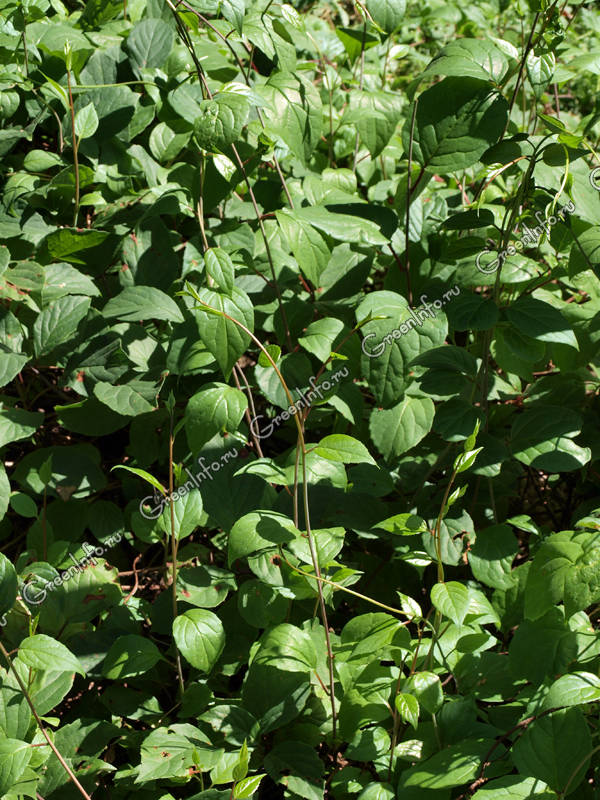

Chinese Schisandra (Schisandra chinensis)
Sometimes lemongrass is grown specifically for tea or medicines, which are prepared from leaves and stems. In this case, the seedlings are planted in three beds. The next year, in August, the plants are mowed from the first bed. In the second year, the second bed is mowed and a year later - the third. During this time, plants grow on the first bed.
The collected green mass, intended for tea, is spread on a cloth or paper and dried for several days in the shade. Store in paper bags until winter. They drink lemongrass tea to recuperate after physical and mental stress. It raises blood pressure in hypotensive patients and may well replace coffee. The invigorating effect of tea lasts 6-8 hours, so it is better not to drink it late in the evening.
Read more about the beneficial properties of lemongrass in the articles:
Schisandra chinensis - the berry of vitality
Schisandra chinensis - help from nature
Schisandra: berry of five flavors and spicy leaves
Lemongrass recipes: from tinctures to tea
Planting a crop with seeds
Seed propagation takes place in the months of April and May. Before sowing, the seeds must be stratified. In autumn, the seed is mixed with moistened sand and stored at a temperature of 5-7 ° C above zero (you can use a refrigerator at home). Once every 14 days, seeds with sand are taken out and aired, not forgetting to mix.
60 days before sowing seeds (in February, March), the container with them is transferred to a warm room (t + 20 ° C) for one month. Then the temperature is lowered to + 8 ° C for 30 days. During the entire period of stratification, the sand should remain moist.
in the photo - the seeds of schisandra chinensis
Sowing of seeds is carried out in pre-prepared grooves 20 mm deep in moistened soil diluted with sand (1: 1). After sowing, the furrows are filled up, slightly compacting the soil, mulched with peat chips with sand (1: 1) in a small layer (2-2.5 cm), then watered. It is advisable to equip the garden bed in a greenhouse. Watering is required rarely, only on hot days in the morning.
After each watering, it is advisable to shake off the grown seedlings from excess water by running your palm over the leaves of lemongrass, allowing them to dry completely. This approach allows you to protect young sprouts from rot. High humidity and high air temperature are detrimental to young seedlings. It is recommended to keep the leaves dry. For better airing of the sprouts, do not sow the seeds too thickly.
For the winter, grown plants in the greenhouse do not require shelter. The next year, the seedlings dive to a permanent place. Usually, seedlings grown from seeds in this way are equivalent to four-year-old vines.

